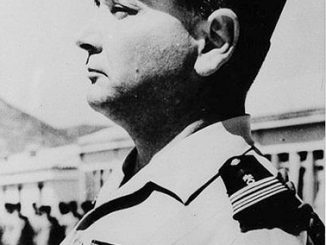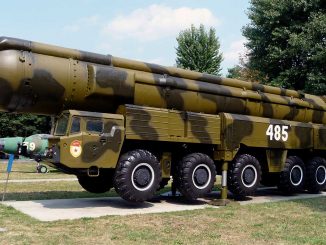There are 5 weapons-oriented goals we are working to address: 1st, in the information area, 2nd in the « strike » area, 3rd, to achieve rapid force projection, global reach, 4th, to develop and deploy credible deterrents and, 5th, to achieve interoperability with our Allies.
Remarks By The Honorable Jacques S. Gansler, Under Secretary of Defense Acquisition and Technology, Air War College, Maxwell AFB, Alabama, January 13, 1999 — Source: DoD —
You, the members of the Class of 1999 here at the Air War College, have been fortunate to have had the opportunity to remove yourselves from the front lines to come to Maxwell Air Force Base to improve your professional skills. This course is difficult, intensive, and time consuming — but worth every hour you spend here. The world has changed dramatically over the last few years and will change even more dramatically as we enter the 21st century. Each of you will significantly affect the outcome. I hope that the course lives up to your expectations and that you live up to the expectations of those who chose you for this important program.
When I first became Under Secretary of Defense for Acquisition and Technology 14 months ago, I set « goals » for progress in achieving the Revolution in Military Affairs and the Revolution in Business Affairs — the dual pillars of our vision for the Department of Defense as it enters the 21st century.
This morning, I would like to take a few minutes to bring you up to date on our progress in achieving these dual revolutions — both in what we buy and how we pay for it; our successes; our lack of success in some instances; some areas where we have special concerns; and our vision for the future. Overall, I am pleased to report that, while we have certainly not reached the full potential of these dual revolutions, we are making steady progress toward that goal. However, what I hope to impart to you today is the urgency of accelerating that progress, due to the extremely dangerous international environment. Not too long ago, we could refer to « future » or « predicted » threats emerging in the early years of the 21st century. Events of the past year — the North Korean missile launch, the attacks on our embassies, the nuclear explosions in India and Pakistan, the repeated cyber attacks on DoD information systems — all these have made us painfully aware that those threats are with us now. In fact, the State Department has warned us that renewed terrorist activity is likely against our installations and personnel in the Middle East within the next 30 days. The presence of armed SWAT teams patrolling the halls of the Pentagon reminds us daily that we are living in a very dangerous world — full of both unpredictable emerging events and an uncertain future.
Preparing for that uncertain future is certainly no easy task. Given the nature of the likely threat we face, our Acquisition and Technology goals focus on three vital priorities: equipping the warfighter of the Year 2010 to assure our security and withstand any potential threat; to accelerate, broaden, and institutionalize acquisition reform in order to improve our ability and resources to provide those weapons; and to modernize our logistics to cut costs, infrastructure, and cycle time in support of our 21st century forces.
Each of these three objectives must meet four essential requirements of our national security: maintaining short-term readiness (we might be at war at any time); providing for long-term readiness by modernizing our warfighting capability for likely future conflicts; reducing the time it takes to accomplish both; and doing all this at significantly lower cost.
As we address these objectives and requirements, we must, first of all, face the reality that, for the next decade, the vast majority of the systems we will use are those that are already deployed. At the end of the Cold War, we stopped modernizing — allowing our procurement account to plummet by around 70 per cent (only recently allowing it to start creeping back up). Thus, today we are spending tens of billions annually to maintain our aging and overworked equipment. Some of our existing Chinook helicopters, for example, although upgraded, are more than 30 years old — many of them saw service in Viet Nam.
The current average age of our aircraft fleet is 20 years — many of them were designed for no more than 15 years of service. Now, even if we include planned procurements, by 2015, the average age will grow to 30 years.
As General Ryan noted during recent testimony before the Senate Armed Services Committee: « modernization is tomorrow’s readiness. If we don’t modernize by replacing aircraft that are beyond their useful life and revitalize those with life left in them, we can expect significant additional maintenance requirements, reduced reliability, and increased costs, as these aircraft grow older. »
The most serious short-term readiness challenge, therefore, is to improve the reliability of the equipment in the field. It’s relatively easy to obtain budget priority for performance improvements on current systems — extending the range of a radar, for example. Yet, it’s very difficult to get priority treatment for reliability improvements. We need to give reliability enhancements to current systems a higher priority and begin to set aside funds for such improvements. It’s difficult, because it requires up-front money. But it will have a three-fold benefit. Increased reliability will have a direct effect on lowering our future maintenance costs while simultaneously increasing readiness. And it will create added dollars to shift into modernization.
The longer we delay reliability enhancements, the more it will cost to support our aging weapons and equipment. If we fail to act now, we will never be able to come out of what I have described as the « death spiral » of escalating support costs and deteriorating equipment. Failure to act now will not only mean delays in fielding new systems, but also cancellation of some programs, due to the requirement to allocate these scarce funds to existing weapons and equipment.
The President announced in his first Saturday Radio Address of 1999 that we will get some relief in our budgeting topline this year. He announced a $12 billion increase in defense spending, most of which will go to finance our involvement in peacekeeping operations in Bosnia, near-term readiness, and pay adjustments. This will help us to solve some of our near-term problems, but not all. To insure long term readiness, we must cut costs and improve performance regardless of any short-term increase in budget top lines. We have no choice. We cannot and should not assume that we can expect significant budgetary allocations to provide both the funds we need to maintain our current readiness and those required to modernize our aging equipment in order to sustain long-term readiness. There is no doubt that we must continue to embrace proven cost reduction practices as we seek to generate additional funds for modernization and combat.
The need to cut costs makes it essential that we keep up the momentum to convince the Congress that we need two more rounds of BRAC. By doing so we can achieve savings of $20 billion by the Year 2015. I realize that our congressional oversight committees have warned us not to come up to the Hill pleading for additional BRAC authority — stating that « we are simply beating the proverbial dead horse ». But we must and we will. The savings from the initial four rounds of BRAC have already been spectacular and well documented. Through FY’01 (the last year of implementation for the fourth round of BRAC in 1995), we will have gained a net savings of $14 billion and can expect an additional $5.6 billion per year thereafter. In fact, independent studies have shown that the costs of these rounds of BRAC were overstated; the savings underestimated; and that, when the communities involved stepped up to the task, recovery was much greater and faster than had been expected. There is no doubt that we can generate additional, significant savings from two more rounds. There is no question that, by becoming more competitive and eliminating our excess capacity, the DoD can support our warfighters much more efficiently and yet much more effectively — providing optimum performance at much lower cost.
All this talk of cutting infrastructure and reducing costs is not just another « budget drill ». It is part of a blueprint designed to assure our present and future national security and absolutely essential to meet my number one priority — providing the weapons and equipment our combat forces and our allies will need to meet our strategic objectives in 2010 and beyond. One of the difficulties of my job is that I must always be looking with one eye to the day ahead and another eye to the distant future — ten or twenty years down the line. What do we need to serve the warfighter in 2010 and insure our national security well into the 21st century?
There are five weapons-oriented goals we are working to address:
- First, in the information area, to achieve an interoperable, integrated, secure, and « smart » command, control, communications, computer, intelligence, surveillance, and reconnaissance (C4ISR) infrastructure that encompasses both strategic and tactical needs.
- Second, in the « strike » area, to develop and deploy — in sufficient quantities — long-range, all-weather, low-cost, precise, and « brilliant » weapons for both offensive and defensive use.
- Third, to achieve rapid force projection, global reach, and greater mobility for our forces. With uncertainty over where they will be required, and the need for extremely rapid response to a crisis anywhere in the world, this capability — when combined with the first two elements — will provide us with overwhelming military superiority.
- Fourth, to develop and deploy credible deterrents and, if necessary, military defense against projected, less traditional early 21st century threats — which include: biological, chemical, and nuclear weapons; urban combat; information warfare; and large numbers of low-cost ballistic and cruise missiles. These threats represent priority issues for our resources — even if it means impacting some of our more traditional areas.
- Fifth and finally, to achieve not only inter-service jointness, but also interoperability with our Allies. This is essential for coalition warfare and even more important given the realization that coalition-driven operations will become the norm, rather than the exception, in the future. We must insure that their technologies compliment those of our forces. To accomplish our goal of information superiority, we are taking steps to make certain that the C4ISR systems and advanced weapons — such as theater missile defense systems — are fully interoperable.
These five working priorities form the backbone of the Revolution in Military Affairs. To pay for these new systems, as you know, we are engaged in an equally important Revolution in Business Affairs. My second priority goal, as Under Secretary of Defense for Acquisition and Technology, is the vital challenge of acquisition reform — in its broadest context — for all the services, and for the Department of Defense, as a whole. There is no question that DoD is a much different place today than it was five years ago and even one year ago. We still have a long way to go and, as I noted earlier, some serious concerns about our ability to sustain long-term readiness due to the demanding short-term maintenance and repair needs of our aging equipment. But, on most fronts, we can report progress and substantial successes in transforming the way the Department does its business: in areas such as use of commercial practices and distribution systems to satisfy materiel acquisition and support requirements; more competitive sourcing of current in-house work; and greatly expanded purchase of common-use, commercially available, goods and services.
In the cost area, two of our specific objectives are to achieve or under run the lower targets set (under « Cost As An Independent Variable ») for at least half of the weapon systems programs undergoing acquisition by the Year 2000, and to reduce the annual support cost per fielded weapon system by 20 per cent by the Year 2005 (as compared to the 1997 baseline).
To achieve these targets, we are seeking increased competition in both development and support. Let me give you just two programmatic examples of how we are completely transforming the way we are doing business. I will start with an Air Force program: the EELV.
The Air Force has used creative business approaches to insure very impressive savings while modernizing the way we launch vehicles into space using an Evolved Expendable Launch Vehicle, or « EELV. » Instead of using traditional sole-source acquisition after a down selection of competitors, and subsequent procurement of separate production and launch operations, we have awarded Lockheed Martin and Boeing competing development contracts and subsequent « launch service » contracts. This continuous competition for the life of the program and the purchase of « launch services » will bring both lower costs and increased producer expertise. Significant cost efficiency will also come from interface standardization that will provide the EELV with the ability to carry both military and commercial payloads. Because of the commonality, with the commercial flights expected to be two-thirds of the total, the contractors will be investing two-thirds of the development costs. And, since the EELV will reduce the cost of launching by at least 25 percent over current Delta, Atlas, and Titan systems, there will be DoD savings of $6 billion in launch costs between 2002 and 2020.
Let me give you one more example.
The Navy’s DD21 program has not only showcased a new way of doing business for our surface ship acquisition community, but it has also put several key ideas for reforming acquisition to work in a « real world » laboratory. Significant DD21 program reform initiatives have included an acquisition approach that leverages industry competition and innovation. Breaking up the so-called « dream team » of Bath Iron Works, Ingalls, and Lockheed Martin and, instead, requiring competition, in the initial concept phase of the program, between teams of shipbuilders and system integrators, assures us the best of weapon system ideas at the lowest future production and support costs — the award criteria. Allowing the teams to enjoy maximum design flexibility has allowed us to mitigate risks and future costs while optimizing systems’capabilities. Then, requiring shipyard competition on the winning design, between the two remaining yards, will provide us with assured competitive production procurements.
As a result of Defense Reform Initiative directives, we have been and will continue to evaluate our entire acquisition process to determine which functions are commercial in nature (i.e., not inherently governmental) and can therefore be subject to public/private competition — financial functions, personnel services, housing, disposal of surplus property, drug testing laboratories, various installation services, much CONUS maintenance, and lots more.
We are convinced that competitive sourcing is the key to getting more for less. DoD has used public/private competitions in more than 2,000 solicitations. These have resulted in about half being awarded to public, and half to private, entities, with 20 to 40 per cent average net savings respectively: and, most important, with significantly enhanced performance in both cases. These same results have been achieved when competitive sourcing has been initiated by both private and public institutions (Federal, State, and local) and by our allies as well. And, significantly, empirical data show that the larger the scope of the competition, the more likely one is able to achieve greater performance and cost benefits.
All of this will be a difficult cultural change for the Department. Yet, it is absolutely necessary. We have many lessons to learn from the private sector and valuable insights to gain into the practices of modern, world-class companies. This does not mean that the DoD should become a business. It means that we want to do our job better by using appropriate lessons learned from the private sector. We are the world’s largest buyer. And we must — in a world of level defense budgets and growing procurement needs — achieve much better performance at greater savings.
Our current acquisition reform effort also seeks to promote further integration of the commercial/military industrial base. We are working to convince world class companies that currently won’t do business with us today to change their minds. This will require us to be more commercial-like in our business practices. Also, we must facilitate the integration of commercial and military operations — at the factory-floor level — within our traditional, and expanded, supplier base. It saves money by allowing the high-volume commercial base to absorb overhead; it improves efficiency; and it allows us to leverage additional commercial products and process technologies.
To achieve this, we must change over to price-based acquisition practices — to establish contractual relationships that use price analysis as compared to cost analysis (either incurred or anticipated). This is the primary way the commercial world functions. This will be the primary way we must function too. Price-based acquisition must become the norm — with cost-based acquisition the rare exception.
In that regard, I might mention that I am working with the General Accounting Office, the Defense Contract Auditing Agency, and others to help us stimulate integration by frequently doing away with, and, in all cases, greatly simplifying, many specialized government accounting and auditing procedures. We cannot expect to be successful in bringing together the commercial and military sectors unless we remove antiquated defense-unique requirements that discourage world-class companies from doing business with DoD.
Another major objective, as we engage in a Revolution in Business Affairs, is to operate on much faster cycle times in order to make the best use of continuing advances in technology. Shorter cycles also reduce costs dramatically. Our goal is to reduce the average acquisition cycle time (measured from program start to initial operating capability) for all program starts in FY 1999 and beyond by 50 per cent over historical averages.
The Department of Defense is not, as I have said, a business, but in those areas where our efforts mirror private sector initiatives we must examine, adapt, and learn. Those examinations, and the lessons learned, are already bearing fruit. The Defense Logistics Agency has experimented with a program through which more than 5,000 Defense Department items are stocked at Federal Express’ 120,000-square-foot warehouse in Memphis, Tennessee. The coordinated efforts of DoD and FedEx have brought about the following significant improvements: 24 hours for domestic delivery, 48 hours for overseas delivery, 99.9 percent accuracy, 98 per cent on-time delivery, and total asset visibility.
This example is just one way in which we can improve our logistics system. Modernization of our defense logistics is my third priority goal — it can have a dramatic, positive performance impact while literally saving billions of dollars annually. At the present time, more than one-third of the U.S. Department of Defense total budget is earmarked for logistics. Nearly 50 per cent of our manpower is in logistics. (In fact, military logistics support personnel outnumber active combat forces by two to one.) Here, as has been clearly demonstrated by world-class commercial logistics organizations, modern technology can come to our aid — dramatically reducing inventory, personnel, and response times. During the past year, we have put in place the expert staff and planning designed to begin a massive transformation of our entire logistics system. That process will remain a top priority and an essential complement to our acquisition reform efforts.
A major logistics objective is to bring about reductions of order-to-receipt time from the current 36-day average — with wide, unpredictable, variations — to under 18 days by the end of FY 2000 — (a 50 per cent reduction) — with far fewer military and civilian personnel and significantly lower inventory levels — and with much greater confidence levels. This means that our warfighters can have confidence that, once ordered, essential items needed for planning, preparing, and participating in operations will actually be there when expected. Information technology and rapid transportation are the keys to improved logistics performance at much lower cost.
It will be difficult to transform defense logistics (some say from a 1950s model) into the modern era, but the potential performance improvements and the cost savings are so spectacular that the effort is clearly worthwhile.
Finally, and absolutely critical to achieving both the Revolution in Military Affairs and the Revolution in Business Affairs, we are working at greatly enhancing the training and education to meet the demands of this urgent transformation effort. This training must be continuous and continually updated. Effective training — for both managers and workforce — will become even more important as we continue to shrink our workforce and as we grant new authority and responsibilities to our program executives. To meet these new responsibilities will require training and education — not on a piecemeal basis — but as an integral part of the acquisition process.
As I noted at the beginning of my remarks, when I took on the responsibilities of this office, I described my goals and priorities for Acquisition and Technology: what I thought was needed to accelerate our role in bringing about the Revolution in Military Affairs and paying for it with the Revolution in Business Affairs. Today, a little more than one year later, I am pleased to report that this effort is well underway. We have had many successes; some failures; and a lot of hard work yet to do. But I am optimistic that we can succeed.
Transformation of the Department of Defense is not an easy job. But, with the support of the Class of 1999, the leaders here in this room, and the many others in the Defense Department’s outstanding acquisition workforce, it can be done.
I repeat my earlier statement that there is a need for a greater sense of urgency to all this: the threat to the United States by the forces of terrorism and from rogue nations is not an illusion or even a possibility. It is real and it is with us now.
Our goal is to pursue a policy that has the compelling force to enable us to act strategically before the forces of terrorism and lawlessness compel us to do so. Only then can we ensure the peace. I am reminded of Elie Wiesel’s simple, but profound, reflection. Peace, he said, « is not God’s gift to his creatures. Peace is our gift to each other. » We cannot sit back and wait for it to come. We must have the courage to work to make it happen.
Thank you very much.










